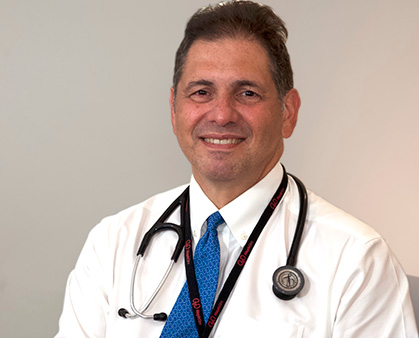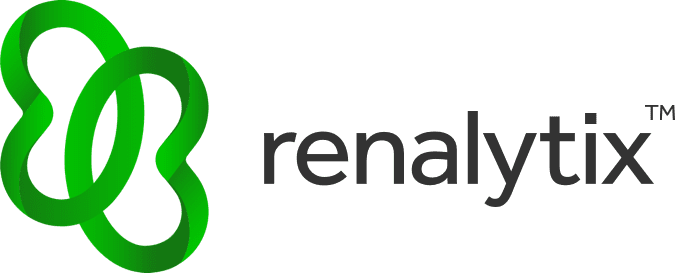A “How To” Playbook for Disrupting Kidney Care: Our Live Chat with the National Kidney Foundation’s Chief Medical Officer
By Elise Wilfinger
09.20.2021

Introduction
Americans spent $3.6 trillion dollars on healthcare in 2018. Medical spending as a percentage of US GDP was near 18% in that same year.1
And within that larger healthcare picture, kidney disease looms large, with incomplete diagnosis, insufficient risk stratification, ineffective treatment implementation, poor health outcomes and a high price tag for patients, employers and taxpayers. To put that in perspective, in 2018, Medicare costs associated with patients with any stage of kidney disease were $130 billion.2
Correspondingly, it’s clear that health care, and kidney care in particular, would greatly benefit from disruptive, non-traditional thinking and new solutions in diagnostics, prognostics and care models.
Recently, I discussed “disruption in kidney care” with Joseph Vassalotti, MD, FASN and the National Kidney Foundation’s Chief Medical Officer since January 2006. Dr. Vassalotti also holds a Clinical Professor of Medicine position in the Division of Nephrology at Mount Sinai Medical Center in New York City.
“…as the population grows and ages, obesity increases
and so too does the prevalence of type-2 diabetes and hypertension…which, in turn, drives a higher prevalence of kidney disease.”– Joe Vassalotti
Elise:
Let’s establish some context for our conversation. How would you describe the state of kidney disease today? Big picture, how did we get here?
Joe:
The current situation clearly shows we have a lot of work to do to improve the care of Americans living with kidney diseases.
- There are an estimated 37 million adults in the US with chronic kidney disease (CKD).2
- Approximately 500,000 Americans are treated with dialysis in a typical year, while 100,000 new patients start dialysis annually in a typical year.2
- And of the 100,000 Americans waiting for a kidney transplant, which would improve their quality of life, only about 25% of them received one in 2020.2
As the population grows and ages, obesity increases and so too does the prevalence of diabetes and hypertension, which, in turn, drives a higher prevalence of kidney disease.
Today’s sedentary lifestyle coupled with diets that are filled with more processed foods fuel the situation.
Elise:
And before we can “disrupt”, what are some of the specific and underlying challenges that we need to understand?
Joe:
Yes, that understanding is critical. Unfortunately, there are many challenges. Here are some most pertinent to our conversation:
1. People don’t experience symptoms.
Most of the 37 million patients impacted are in the earlier stages of the disease and feel well. And since only 10% are even aware of CKD2, they cannot become engaged in better disease management and lifestyle modification.
2. Testing is inadequate.
Physicians typically look at estimated GFR and urinary albumin creatinine ratio levels, but some believe that these measurements are inadequate in identifying those select patients who are more likely to experience progressive decline in kidney function.
That said, these are the tests recommended by both the NKF KDOQI and the KDIGO clinical practice guidelines today.
One of the biggest barriers is the lack of testing: less than 50% of people with diabetes are tested annually and less than 10% of people with hypertension are tested annually.3 We need to focus on increasing the testing.
3. Risk control is limited.
There are established targets to control risk factors for patients with a predisposition to kidney disease (e.g., those with diabetes), but they are not often met. The 130/80 blood pressure target for people with diabetes is achieved less than 50% of the time. The hemoglobin A1C target of 7 with kidney disease is achieved about 40% of the time.4
And the use of protective kidney disease medications – ACE inhibitors or angiotensin receptor blockers, which are primarily used for the treatment of hypertension and evidenced-based for the combination of hypertension with albuminuria- are only prescribed 30-40% for CKD management.4
Medications that reduce cardiovascular events – statin or cholesterol-reducing treatments – are used only 1/3 of the time, when we know these will reduce the risk of heart attack and stroke.4
4. Diverse populations suffer at a greater rate.
African Americans make up about 13% of the U.S. census population but comprise 35% of the patients who are being treated with dialysis. Similar inequities exist for Hispanics, Asians, Pacific Islanders and American Indians.2
5. And the divide has widened with COVID-19.
We’ve learned that COVID-19 is not just a pulmonary virus, it also impacts the kidneys.
The number of acute kidney injuries (AKI) in hospitalized patients has increased as has the kidney disease mortality rate with the advent of COVID.5
In fact, a new comprehensive report shows that people hospitalized with COVID-19 are at significant risk of AKI, which can lead to the need for dialysis, and even death. The study found patients with COVID-19, who were hospitalized between March 11 and April 26, were twice as likely to develop AKI as compared to non-COVID patients who developed AKI during the same time period in 2019 – 56.9% versus 25.1% respectively. AKI appears to be a marker of COVID-19 infection severity and the mortality rate is higher for these patients.5
6. Overall CKD care has also taken a hit with the pandemic.
- COVID-19 has caused kidney diseases to worsen in many patients due to acute kidney injury
- With the understandable focus on COVID-19, there was an increase in virtual visits. But these virtual visits only partly compensated for the decrease in the in person visits. Further, there was a reduction in lab work in 2020,6 including blood and urine testing to identify and monitor kidney diseases.
- There has been a reduction in the number of patients with kidney failure in 2020 for the first time since data collection began in America by the United States Renal Data System. In fact, 20% fewer patients started dialysis during the peak pandemic weeks compared to historical data.7 Why? Two reasons: deaths as a result of COVID-19 and, also the decision by nephrologists to delay the initiation of dialysis because of the pandemic.7
“First, we must acknowledge that Kidney Care in America, like all health care here, is excellent ‘sick care.’ We need to take care upstream, where we’re talking about kidney health: protecting and preserving the kidneys.”
– Joe Vassalotti
Elise:
So, is it possible to disrupt kidney care with difference-making strategies? And what playbook would you follow?
Joe:
Absolutely, we can make a difference. Here’s where I’d place the focus:
1. Shift the paradigm from excellent sick care to excellent well care.
In the U.S., we have exceptional academic medical centers and hospital systems. We’re also in a class by ourselves when it comes to treating acute diseases.
But our ‘fee for service,’ reimbursement model does not reward preventative care or chronic disease management. Physicians who care for patients who do poorly are reimbursed at a higher rate than those with patients who are well managed and have fewer complications and delayed kidney failure.
For example, CKD Medicare costs increase with each stage of the disease, with an average $36,000 per year for patients with advanced pre-dialysis, kidney disease and approximately $95,000 per year for dialysis.8 So if we can delay the loss of kidney function, we will improve outcomes and contain costs.
Imagine if we caught the disease earlier?
If we focus on slowing down the trajectory of the disease by focusing on upstream kidney health, we can significantly increase positive patient outcomes and significantly reduce costs as primary care intervention studies have shown.9
2. Leverage patient fear as motivation for action.
Kidney disease is unique in that patients are frightened of dialysis. It has a very negative connotation in our culture, for its perceived and real impact on quality of life.
At the National Kidney Foundation, we believe that this fear can be leveraged to motivate patients toward improved self-care, including addressing risk behaviors, making lifestyle changes and being more committed and engaged with their healthcare team.
That’s why we’ve recently joined forces with the U.S. Department of Health and Human Services (HHS), the American Society of Nephrology (ASN), and actor, activist and entrepreneur Wilmer Valderrama to reach the 1 in 3 American adults at risk for kidney disease.
This partnership resulted in the “Are You the 33%?” campaign10, which is geared to building awareness among the 33 percent of adults in the U.S. at risk for developing dangerous, life-threatening kidney disease.
Our hope is that this campaign will raise visibility with the general public and mobilize the kidney community of patients, nephrologists and health professionals to promote new approaches to prevent, diagnose, and treat kidney disease.
The campaign helps patients understand why they may be at a higher risk by educating them on the risk factors, including having diabetes, heart disease, high blood pressure, obesity and family history of kidney disease. People of color, including Black or African American and Hispanic or Latinos, are also at greater risk of developing kidney disease, for complex reasons, particularly social determinants of health. The campaign helps to inform the public about risk and provide initial next steps: to seek care of primary care physicians, discuss kidney health risks, and to get tested.
3. Testing. Period.
The US Preventive Services Taskforce should immediately recommend testing for kidney disease in patients with diabetes, hypertension and/or cardiovascular disease.
“One PCP told me that ‘Kidneys don’t cough’.
And he was right.”– Joe Vassalotti
4. Integrate upstream kidney care into primary care.
Until now, most disruption has been focused on later stage care. For example, there have been advancements in dialysis and transplantation. But we need to focus upstream, preempting progression to the later stages.
In the earlier stages, care would largely be managed by a patient’s primary care physician. This dictates the need for integration with primary care and an incorporation of kidney care into the workflow of the PCP.
One of the challenges is that, as one primary care physician told me, ‘Kidneys don’t cough’.
Because their patients don’t exhibit symptoms early, kidney health is not top of mind. And because patients with kidney disease are already highly complex (e.g., have hypertension, type-2 diabetes, cardiovascular disease and often, other comorbidities), managing them takes more time and is more challenging. That’s why it’s critical to find ways to help PCPs risk stratify patients to better match the interventions to the risk.
5. More broad-scale use of clinically-proven medications.
Unexpectedly, large scale clinical trials have demonstrated that SGLT2 inhibitors not only reduce blood glucose in type-2 diabetes (original intended use), but achieve what many of the commonly used diabetes agents failed to do: robustly ameliorate the progression of kidney disease by 25-40%.11
Moreover, they reduce the risk of cardiovascular events, heart failure, and death. These drugs are clearly game-changing, and new data continues to emerge on how they act through the kidney (increasing urine excretion of glucose) and how they yield kidney and cardiovascular benefits even in patients without type-2 diabetes who have CKD, heart failure or both.10
6. Reinvigorate the momentum of 2019.
I agree with many of my colleagues that 2019 was the most exciting year in the field of kidney care since 1972, because of the publication of the CREDENCE trial12 and the Advancing American Kidney Health Initiative. Not since the early 1970s, when dialysis became a Medicare-covered medical treatment, has there been such a momentous time.
Unfortunately, COVID-19 slowed both progress and momentum in 2020. We would, therefore, greatly benefit from a jump start, especially as it relates to The Advancing American Kidney Initiative Executive Order.
This Executive Order was an action to address head-on the burden of kidney care. According to HHS Secretary Alex Azar in a July 10, 2019 press release, HHS To Transform Kidney Care Delivery for Patients With Chronic Kidney Disease, we’ve spent “decades paying for sickness and procedures in kidney care (in the fee-for-service model), rather than paying for health and outcomes (in a value-based model), which has produced less-than-satisfactory outcomes at tremendous cost. Through new payment models and many other actions under this initiative, the Trump Administration will transform this situation and deliver Americans better kidney health, more kidney treatment options (particularly home dialysis) and increased access to kidney transplantation.”
The Executive Order also outlined specific and aspirational goals13 for kidney health, which I believe can be met.
- Reducing the number of Americans developing end-stage kidney disease by 25 percent by 2030
- Having 80 percent of new ESKD patients in 2025 either receiving dialysis at home or receiving a transplant
- Doubling the number of kidneys available for transplant by 2030
Elise:
What collaborations have the National Kidney Foundation fostered to improve diagnosis and treatment of kidney health?
Joe:
We’re excited about the new Kidney Health Evaluation for Patients with Diabetes measure in partnership with the National Committee for Quality Assurance (NCQA). The new HEDIS measure will improve kidney disease testing in people with diabetes which is a key risk factor for developing kidney disease.
Clinical practice guidelines recommend that people with diabetes be routinely tested to detect kidney disease. While the tests associated with kidney disease detection and diagnosis are inexpensive and widely available for routine clinic visits, less than 50% of people with diabetes receive both tests annually in the U.S. The new Kidney Health Evaluation HEDIS Measure will reveal these gaps in care for clinicians, healthcare leadership and health plan executives. Moreover, the availability of both these tests will more precisely risk stratify patients for kidney protective therapies and provide the raw data necessary for kidney population health management.
“The moonshot? We need clinical and science-based investigation for how to cure kidney disease.”
– Joe Vassalotti
Elise:
You’ve shared many ideas for what seems possible to start actioning today. Are there any promising moonshots?
Joe:
I think that’s a great, forward-thinking question. And there’s only one real answer. The moonshot: clinical science-based investigation for how to cure kidney disease.
If you enjoyed this post, we’d be grateful if you would help us spread its content.

